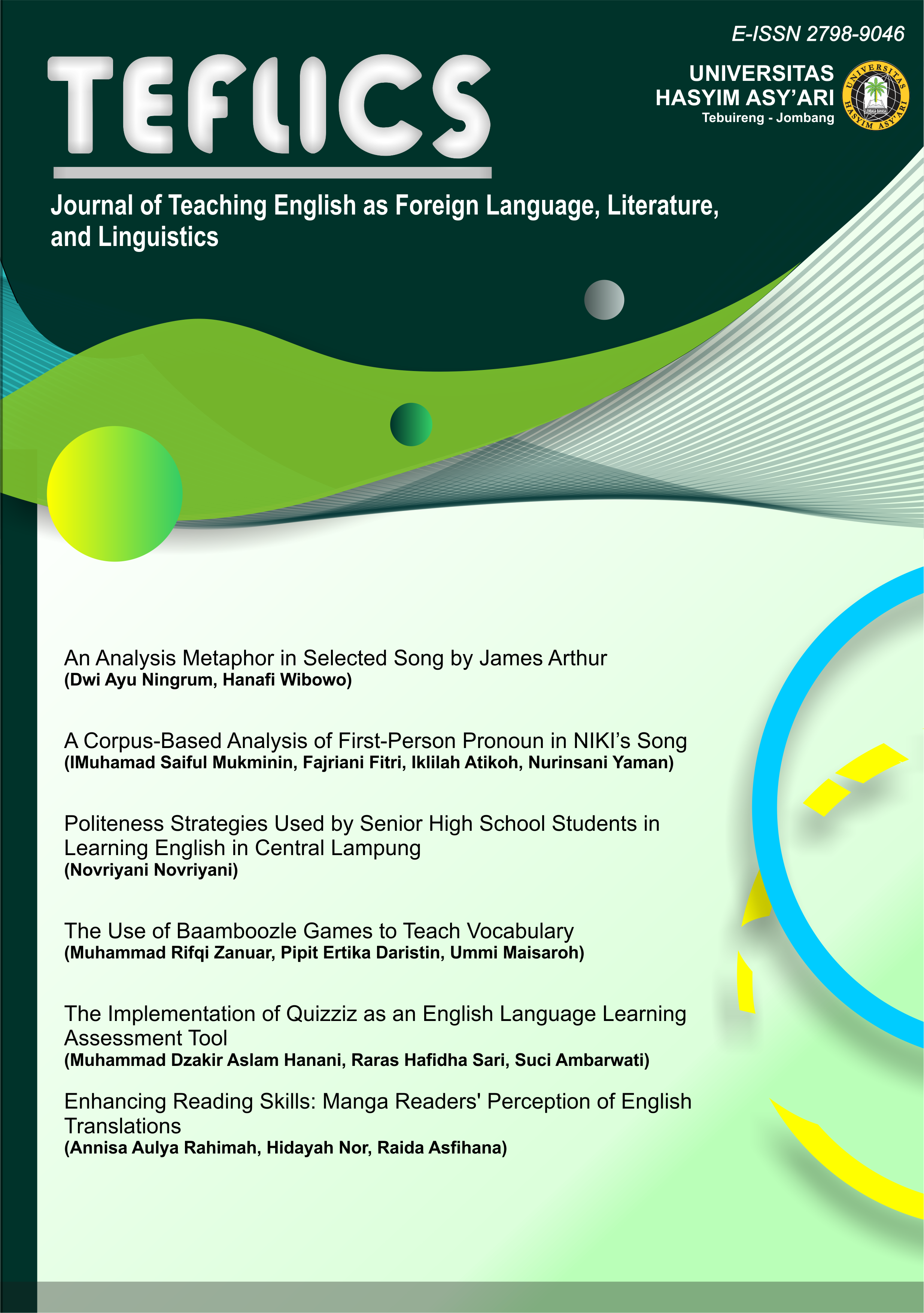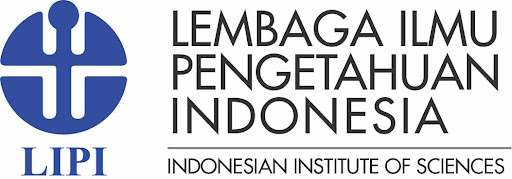Enhancing Reading Skills: Manga Readers' Perception of English Translations
DOI:
https://doi.org/10.33752/teflics.v4i2.7459Keywords:
English Translation; Manga Readers; Perception: Reading SkillsAbstract
This research is examining the perceptions of manga readers towards English-translated manga and its impact on their reading skills. It evaluates both micro and macro aspects of reading skills enhancement. Employing a convergent mixed methods approach, data was collected in two phases: qualitative interviews with 15 active manga readers and quantitative questionnaires with the same participants. Results indicate a positive perception among manga readers towards English-translated manga, facilitating self-directed learning and enhancing English reading skills. Improvement spans across various reading skills, including linguistic aspects such as grammatical form and word meaning, and macro skills like identifying main ideas and extracting general information. The study, conducted at the English Education Department of Antasari State Islamic University Banjarmasin, suggests that English-translated manga effectively attract readers and motivate them to engage with English materials. Recommendations for future research include exploring similar media formats like webtoons or comics, investigating other reading skills such as writing, and conducting further tests to assess the extent of reading skill improvement among manga readers.
Downloads
References
Aliyah, L. N. (2013). The Use of Manga to Teach Reading Narrative Text to Tenth Graders of SMAN 1 Cerme. e-Journal Unesa Vol. 1: 2-5. http://jurnalmahasiswa.unesa.ac.id/index.php (accessed 2022-04-10)
Arsyad, S. N. (2020). The twitter Role-Player Perception on The Role of Role Playing in Improvement Writing Skills. Banjarmasin: Antasari State Islamic University.
Brown, H. D. Abewickrama, P. (2010). Language Assessment: Principles and Classroom Practice (2nd ed.). New York: Pearsun Education Inc.
Budi, W. (2015). The Influence of English Translated Manga to Students’ Reading Comprehension. https://www.academia.edu/43293634/Article_The_Influence_of_English_Traslated_Manga_to_Students_Reading_Comprehension (accessed 2022-04-07).
Creswell, W. John, J. David Creswell, (2018). Fifth Edition Research Design Qualitative, Quantitative and Mix Methods Approaches.
Destrianty, E., Syafriza, S., Gita, M. H. (2018). The Perception of The English Club Members of The English Department Students Association (EDSA) Toward Their Club. Journal of English Education and Teaching (JEET), Vol. 2: 3. https://doi.org/10.33369/jeet.2.3.1-6
Fadli, M. R. (2021). Memahami Desain Metode Penelitian Kualitatif. Humanika, Kajian Ilmiah Mata Kuliah Umum, Vol. 21(1): 33-54. https://doi.org/10.21831/hum.v21i1.38075
Faizin, A., Asyari, M. H. (2016). Developing Reading Exercises. Jurnal Fakultas Sastra Universitas Gresik. Vol. 5: 2. http://journal.unigres.ac.id/index.php/AESTHETICS/article/view/822 (accessed 2023-05-10)
Faza, Z. (2019). Students’ Perception of Reading Grapic Novel to Improve Reading Comprehension. Banda Aceh: Universitas Islam Negeri Ar-raniry.
Fetters, M. D., Curry, L. A., Creswell, J. W. (2013). Achieving Integration in Mixed Methods Design Principles and Practices. Health Services Research. Vol. 48(6 Pt 2): 2134-2156. https://doi.org/10.1111/1475-6773.12117
Gaspersz, V. (1997). Manajemen Bisnis Total dalam Era Globalisasi. Jakarta: Penerbit PT. Gramedia.
Gilakjani, A. P., Sabouri N. B. (2016). A Study of Factors Affecting EFL Learners’ Reading Comprehension Skills and the Strategies for Improvement. International Journal of English Linguistics, Vol. 6: 5. https://doi.org/10.5539/ijel.v6n5p180.
Gusmeri, Sri U. (2020). The Effectiveness of Using Online Comic Strips on Students’ Reading Comprehension of Narrative Text. Jakarta: Universitas Islam Negeri Syarif Hidayatullah.
Hasanah, N. (2020). Media Komik Dalam Meningkatkan Keterampilan Membaca Siswa di Gubuk Baca Sekolah Pagesangan Wintaos Gunung Kidul. Jurnal Transformarif, Vol. 4: 1. https://doi.org/10.23971/tf.v4i1.1891
Ismail, H., Juang, K. S., Basuki. (2017). Improving the Students’ Reading Skill through Translation Method. Journal of English Education JEE, Vol. 2: 2. https://doi.org/10.31327/jee.v2i2.405
Jaya, A. (2017). Utilizing Manga to Increase Students’ Reading Comprehension on Narrative Text of Second Year Students at SMAN 19 Makasar. Makasar: Alauddin State Islamic University of Makasar.
Kholili, A. (2022). Upaya Meningkatkan Pemahaman Membaca Bahasa Inggris Melalui Pembelajaran Berbasis Inkuiri (Inquiry-Based Learning). Jurnal Pengabdian pada Masyarakat, Vol 2: 2. https://doi:xxx/ejpm.v%i%.xxxx
Kunai, I., Ryan, C. C. S. (2007). Manga as a Teaching Tool: Comic Book Without Borders.
Kusniyah, N. L. (2021). The Practical Use of Online Comic Manga: Facilitating Students’ English Reading Engagement. Al-Ishlah: Jurnal Pendidikan, Vol. 13: 3. https://doi.org/10.35445/alishlah.v13i3.1265
Linse, C. T. (2005). Practical English Language Teaching. New York: Grow-Hill Companies.
McLeod, S. (2018). Questionnaire: Definition, Example, Design, and Types. https://www.simplypsychology.org/questionnaire.html (accessed 2022-04-20).
Miles, M. B., Huberman, M. (2014). Qualitative Data Analysis: A Methods Sourcebook - Third Edition.
Munandar, I., Srimurni. (2021). Directed Activity (DRA) Aplication in English Reading Comprehension Classroom. Jurnal As-Salam, Vol. 5: 1. https://doi.org/10.37249/assalam.v5i1.243
Murakami, S., Bryce, M. (2009). Manga as an Educational Medium. Journal of The Humanities, Vol. 7: 10.
Ningsih, S. (2021). The Line Webtoon of Comic Application in Reading Skill at SMA YKHS Sepulu. Bangkalan: STKIP PGRI Bangkalan.
Novinggi, V. (2019). Sensasi dan Persepsi pada Psikologi Komunikasi. Al-Hikmah Media Dakwah, Komunikasi, Sosial dan Kebudayaan, 10(1): 40-51. https://doi.org/10.32505/hikmah.v10i1.1706
Nurhayati, D. (2013) The Development of Moodle Based English Reading Material (A Case at Multimedia Department Student to Year Tenth of Telekomunikasi Tunas Harapan Vocational High School Semarang). Vol. 8: 2. https://doi.org/10.15294/lc.v8il.327
Nurviyani, V., Didi S., Iwa L. (2020). Developing Students’ Reading Skill Through Making Multimodal Inferences. Vol. 8: 2. https://doi.org/10.25134/erjee.v8i2.2998
Rijali, A. (2018). Analisis Data Kualitatif. Alhadharah Journal, Vol. 6: 3. https://doi.org/10.18592/alhadharah.v17i33.2374
Rokhayani, A., Utari A. R. P. (2014). The Use of Comic Strips as an English Teaching Media for Junior High School Student. LANGUAGE CIRCLE Journal of language and Literature, Vol. 8: 2. https://doi.org/10.15294/lc.v8i2.301
Saniyah, A. (2011). Kelompok Penggermar Manga Online (Online Manga Fandom). Journal Unair ,Vol. 3: 1.
Sari, D.K., Etty, P., Ana, T. (2019). Effective Reading Strategies for Reading Skills. Journal of English Study Programme, Vol. 2: 2. https://doi.org/10.31851/esteem.v2i2.2429
Schwartz, A., Rubinstein A.E. (2006). Understanding The Manga Hype: Uncovering The Multimodality of Comic-Book Literacies. Journal of Adolescent and Adult Literacy, Vol. 50(1): 40-49. https://doi.org/10.1598/JAAL.50.1.5
Sinulingga, E. R. (2018). The Use of Two Stay-Two Stray Though Manga on The Students’ Achievement in reading Comprehension. Medan: University of Muhammadiyah Sumatera Utara.
Spielman, R . M. (2017). Psychology. Texas: Rice University.
Supitri, S. (2019). The Effect of English Comic Webtoon on Students’ Reading Comprehension at Madrasah Tsnawiyah Negeri 2 Muaro Jambi. Jambi: The State Islamic University Sulthan Thaha Saiffuddin.
Walgito, B. (2004). Pengantar Psikologi Umum. Yogyakarta: Andi Offset.
Zalmansyah, A. (2013). Increasing the Students’ Vocabulary by Using Comic Strips as an English Teaching Media. Jurnal El Badan Bahasa, Vol. 9: 2. https://doi.org/10.26499/jk.v9i2.292.

Downloads
Published
How to Cite
Issue
Section
License
Copyright (c) 2025 Teaching English as Foreign Language, Literature and Linguistics

This work is licensed under a Creative Commons Attribution-ShareAlike 4.0 International License.















